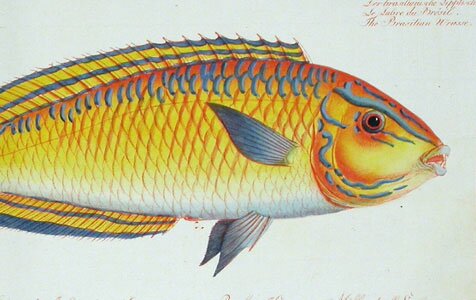Fishes
From Microcosm Aquarium Explorer

- Flying Fish print (detail). Marcus Elieser Bloch
- Fantail Filefish Fishes of Hawaii

- "Orange Brazilian Wrasse" print (detail). Marcus Elieser Bloch
- Longnose Butterflyfish print. Fishes of Hawaii
- Peacock Flounder print (detail). Marcus Elieser Bloch
Fishes: A Definition
A fish is a cold-blooded, finned aquatic vertebrate. Most fishes are scaled and respire by passing water over their gills. A relatively small number of fishes are scaleless and some are able to breathe air directly from the surface of the water. A few highly unusual species can survive for varying periods out of water.
Fishes:
Fish Facts
- Statistics
- Largest Species
- Heaviest Species
- Smallest Species
- Fastest Species
- Oldest Species
- Most-Fecund Species
The Fishes: A Snapshot
- Of all living vertebrates, the fishes make up more than half of the approximately 55,000 known species.
- Species of Fishes (including subspecies): 30,121
- Primarily Marine: 14,021 (47%)
- Primarily Freshwater: 13,228 (44%)
- Brackish or Diadromous: 2,871 (10%)
- Fish Anatomy
Ichthyospeak
- Ichthyologist: One who studies fishes.
- Ichthyology derives from the Greek: ikhthu (fish); and logos (knowledge); it is a branch of zoology devoted to the study of fishes.
- Fish: a single specimen or a group that includes only members of the same species.
- Fishes: more than one species of fish.
Classes of Fishes
Modern fishes are divided into three classes:
- AGNATHA: primitive jawless fishes, such as lampreys and hagfishes.
- CHONDRICHTHYES: jawed fishes with cartilaginous skeletons, such as the sharks and rays.
- OSTEICHTHYES: fishes with bony skeletons, by far the largest group, with everything from guppies to moray eels, piranhas, and giant groupers.
Need help? Read the Species Profiles instructions for Fishes.









